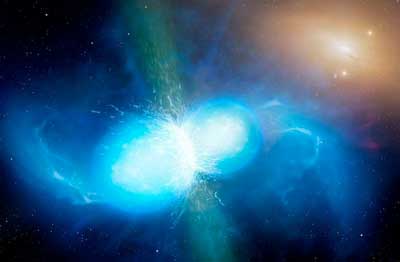| Dec 30, 2020 |
How large are neutron stars?
|
|
(Nanowerk News) An interdisciplinary research team has identified new, narrower limits on the radii of neutron stars. The team included nuclear physicists, data scientists, and astronomers. Their novel approach combined two sources of information. These sources were the first gravitational-wave and electromagnetic observations of a binary neutron-star collision and modern nuclear-theory calculations of uncertainty.
|
|
The team determined the radius of a typical neutron star to be close to 11 kilometers. The results (Nature Astronomy, "Stringent constraints on neutron-star radii from multimessenger observations and nuclear theory") suggest that neutron-star black-hole collisions can swallow neutron stars whole.
|
 |
| An artist’s impression of the collision of two neutron stars. This collision causes gravitational waves, a gamma-ray burst, and a massive explosion. Scientists believe the explosions are the universe’s main source of heavier elements such as gold. (Image: ESO/University of Warwick/Mark Garlick)
|
|
Neutron-star collisions teach us about the nature of the densest matter in the Universe. The properties of this matter can be understood in part by measuring the radii of neutron stars.
|
|
Until recently, observers inferred that typical neutron-star radii ranged from 10–14 km with large uncertainties. The present work determines the neutron-star radius independently and more accurately.
|
|
The improved constraints will have implications for the interpretation of future observations of neutron stars and will help scientists better understand the universe.
|
|
Neutron stars are the remnants of supernova explosions and have extreme properties. In particular, the cores of neutron stars are made up of extremely dense nuclear matter. When two neutron stars collide, they give off gravitational waves, electromagnetic radiation, cosmic rays, and neutrinos, so-called multi-messenger signals. Scientists observed one of these binary neutron-star collisions with several multi-messenger signals in August 2017.
|
|
Using a new approach, a research team combined observations with state-of-the-art nuclear theory and used supercomputers to calculate the properties of neutron star matter. Finally, using Bayesian statistical tools, the team combined these calculations with the multi-messenger observations to constrain the radius of the neutron stars.
|

